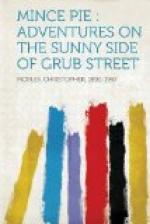R.C.H. of N.B. Tarkington.
Mr. Holliday was born in Indianapolis on July 18, 1880. It is evident that ink, piety and copious speech circulated in the veins of his clan, for at least two of his grandfathers were parsons, and one of them, Dr. Ferdinand Cortez Holliday, was the author of a volume called “Indiana Methodism” in which he was the biographer of the Rev. Joseph Tarkington, the grandfather of Newton B. Tarkington, sometimes heard of as Booth Tarkington, a novelist. Thus the hand of Robert C. Holliday was linked by the manacle of destiny to the hand of Newton B. Tarkington, and it is a quaint satisfaction to note that Mr. Holliday’s first book was that volume “Booth Tarkington,” one of the liveliest and soundest critical memoirs it has been our fortune to enjoy.
Like all denizens of Indianapolis—“Tarkingtonapolis,” Mr. Holliday calls it—our subject will discourse at considerable volume of his youth in that high-spirited city. His recollections, both sacred and profane, are, however, not in our present channel. After a reputable schooling young Robert proceeded to New York in 1899 to study art at the Art Students’ League, and later became a pupil of Twachtman. The present commentator is not in a position to say how severely either art or Mr. Holliday suffered in the mutual embrace. I have seen some of his black and white posters which seemed to me robust and considerably lively. At any rate, Mr. Holliday exhibited drawings on Fifth avenue and had illustrative work published by Scribner’s Magazine. He did commercial designs and comic pictures for juvenile readers. At this time he lived in a rural community of artists in Connecticut, and did his own cooking. Also, he is proud of having lived in a garret on Broome street. This phase of his career is not to be slurred over, for it is a clue to much of his later work. His writing often displays the keen eye of the painter, and his familiarity with the technique of pencil and brush has much enriched his capacity to see and to make his reader see with him. Such essays as “Going to Art Exhibitions,” and the one-third dedication of “Walking-Stick Papers” to Royal Cortissoz are due to his interest in the world as pictures.
While we think of it, then, let us put down our first memorandum upon the art of Mr. Holliday:
First Memo—Mr. Holliday’s stuff is distilled from life!
CHAPTER III
(IN WHICH OUR HERO DARTS OFF AT A TANGENT)
It is not said why our hero abandoned bristol board and india ink, and it is no duty of this inquirendo to offer surmise. The fact is that he disappeared from Broome street, and after the appropriate interval might have been observed (odd as it seems) on the campus of the University of Kansas. This vault into the petals of the sunflower seems so quaint that I once attempted to find out from Mr. Holliday just when it was that he attended courses at that institution.




